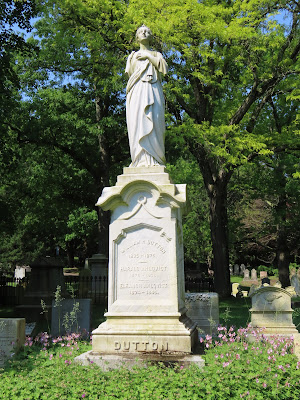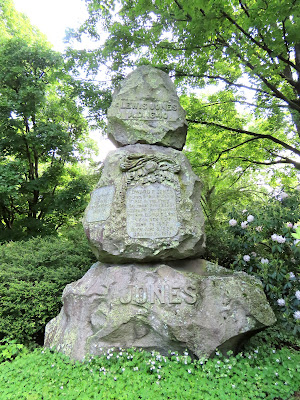It is called Mount Auburn and has the distinction of being the first of its kind in America: a landscaped rural garden Victorian cemetery.
Mount Auburn opened in 1831. Today it encompasses 170 acres in Cambridge and also parts of neighboring Watertown. More than 100,000 people are buried here.
Wow!
More on Mount Auburn's history here.
The impressive entrance near Harvard University was built in 1842 of locally- quarried Quincy granite. The wings at the top are of ancient Egyptian influence symbolizing the sun and therefore power, according to cemetery material.
The inscription under the rings says the following:
“Then shall the dust return to the Earth as it was and the Spirit shall return unto God who gave it.” Ecclesiastes 12:7”
Credit for founding this Garden of Eden of burial grounds is Dr. Jacob Bigelow (1787-1879), a Boston physician, botanist and Harvard professor. Bigelow chapel, (right) located near the entrance, was named in his honor. The grand Gothic Revival edifice, built in 1844 and rebuilt in 1855 (also of Quincy granite) emulates the style of cathedrals built in England, France and Germany in the 1200s or 1300s, a cemetery publication says.
England and France had started cemeteries in outlying areas for similar concerns (see my 2017 post on Paris' Pere Lachaise Cemetery and Montparnasse Cemetery).
The newly formed Massachusetts Horticultural Society located a 72-acre farm that seemed ideal for such a planned garden cemetery.
The planners saw an enticing part of the property, a 125-foot hill that offered views of Cambridge and Boston.
This 62-foot-tall observation site, called Washington Tower for the first U.S. president, was erected in 1852.
The view at the top is expansive. The tower is not open year round, only April through October.
Also visible from Washington Tower was this Dick’s Sporting Goods blimp. We weren’t sure what it was doing on this Sunday morning, maybe the Red Sox had a home game at Fenway Park. There was also a big music festival going on in the Boston area that weekend.
You can see the blimp between the pair of obelisks. The Boston skyline is in the background.
A cemetery with an observation tower- another first for me. Mount Auburn is a place of many firsts in America. It inspired the rural cemetery movement in the U.S. This included the opening of Charleston's Magnolia Cemetery in 1850.
Now here’s an eye-catching monument! It is called, not surprisingly, The Sphinx. No one is buried in it or underneath it. Installed in 1872, The Sphinx was commissioned by cemetery founder Jacob Bigelow and carved in Hallowell granite by Martin Millmore. The sculpture’s purpose commemorates the end of slavery in the U.S., according to a cemetery publication geared toward children.
So I guess you could say that slavery is buried below the half-human half-lion creature.
To me, it’s curious that a cemetery would be the site of such a symbol and statement.
Online can be found a site that says Bigelow wanted The Sphinx to honor Union soldiers who died in the Civil War. One wonders why the Mount Auburn children’s handout doesn’t say that.
The Sphinx was one of the first sites we visited after arriving at Mount Auburn on a quiet Sunday morning (May 26) in Cambridge. We got there before 9:30 and would stay for about two hours. I could have spent twice as long but we needed to get back to the hotel in Cambridge to gather our things to move to our hotel in Boston.
We enjoyed a leisurely walk around the grounds covering maybe half the 170 acres but enough to be very impressed. My expectations were exceeded by the overall beauty, the flora and fauna, and the remarkable variety of gravestones, large and small.
The cemetery features many large and ornate mausoleums. This one was built for Ralph Huntington White (1841-1917) who was a successful owner of his longtime namesake R.H. White department store in Boston.
Robert C. Winthrop and several family members (presumably) reside in this mausoleum. Winthrop (1809-1894) was from a prominent Boston family. A lawyer, we served in the U.S. House of Representatives (becoming Speaker of the House) and U.S. Senate. Below his name (above) lists several of his attributes (orator, statesman, philanthropist) then end with “Above All A Christian.” I like that!
This is an interesting capture I made inside the Sanford mausoleum. Edward has several relatives in there with him. If you make the photo larger you may be able to make out some of the names. Edward’s niche or shelf is second row from the right, third one down.
Interred in the ground around the large monument are Isaac H. Russell (1822-1895), Mary Scott (1790-1878) and Mary A. Shaw (1815-1836)- just 21 when she passed. Other names are inscribed on the pedestal’s other sides.
I like the star on her head. Stars can represent divine guidance in cemetery iconology. If the star has five points, as does this one, it represents the Star of Bethlehem. If a star has six points, it would mean the power of God’s creation.
It is fairly rare to have two full-sized figures like this. The woman is on her knees mourning, clutching a cross to her heart, as she gazes to the heavens. An angel stands above her. The inverted torch in his (I believe this is a male angel) left hand symbolizes the end of life but also the hope of life everlasting in Heaven. In his right hand, he seems to be pulling a blanket or garment over the woman's head and face as if she is passing from life to death to life everlasting.
Also on this Chickering monument we have another sorrowful figure with her head bowed, holding a musical instrument, a lyre. Perhaps she is Erato, the Greek Muse who was the inspirational goddess of literature, science and arts. Perhaps the image also represents that the music is over for the Chickering family members interred below. A musical connection would be appropriate for “piano magnate” (Find a Grave description) Jonas Pickering (1798-1853) who built a successful piano-making business in Boston. His company built 12,000 pianos by the time Jonas died.
A dog has a prominent spot in this elaborate columned memorial. The word Charity is engraved at the top.
The choice of including a hound dog is an interesting one. A dog can be part of a grave marker to “express” fidelity and/or as a sign of love and family affection.
A dog is also central to this Perkins plot. It holds the eternal remains of four family members who died between 1854-1889. The loyal dog, perhaps the likeness of a loyal pet who will protect the family for eternity.
Three more Union officer deaths follow. I’m sure this cemetery has many more.
Col. P.S. Davis of the 39th Regiment Massachusetts Volunteers was “killed in front of Petersburg, Va., July 11, 1864” at age 46. That's a reference to the protracted Union army siege of Petersburg, Va.
I was excited to score a first-time “lifer” bird at the cemetery. This is a House Wren. It does resemble the state bird of South Carolina, the Carolina Wren.
And here we have an Eastern Phoebe. I have previously photographed this species of the Tyrant Flycatchers (sounds dramatic!) in my backyard and a few other places in the Charleston area. Check out my Eastern Phoebe post from way back in 2012.











































































No comments:
Post a Comment